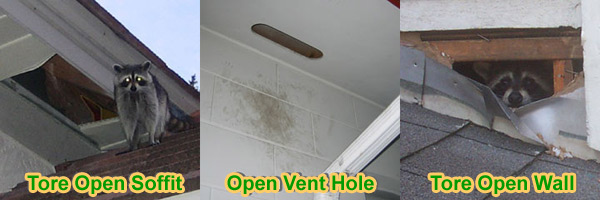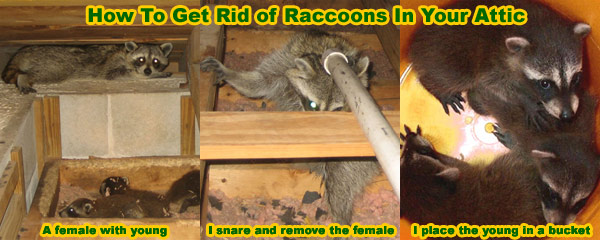If you want to try to remove the raccoons yourself, read my
Trap it Yourself guide
in addition to below.
If you want to hire a professional to help you, go to my
Hire a Pro page
for a guy in your home town.
If you do hire a company, you can read my
How Much Does Raccoon Removal Cost? page.
Raccoon prevention – how to keep raccoons away from your house and yard
Just like most things in life, prevention is better than cure and when it comes to unwanted visitors in your home, such as raccoons, preventing them from entering is going to be a much easier process than encouraging them to leave!
Luckily, there are more than a few things that you can ensure that you do to stop these unwanted visitors. They are crafty little animals, so you will have to be more than a little crafty yourself, but with these simple steps and tips, you will find your humble abode rodent and animal free in no time at all!

First things first – why do animals come into your home? Of course they are looking for shelter and somewhere to have babies, but more importantly than that, they need food in order to survive. If you regularly have food on the kitchen floor with the back door open, or put food on your porch for the birds or beloved pet cat, stop doing so. Any food that is left lying around in your home is like a big neon sign to unwanted animals such as raccoons, rats, squirrels and the suchlike. If you take the food out of the equation, you are already halfway to winning the battle.
One thing that people often turn to when they want to prevent an animal from entering their home is a repellent of some description. These normally come in the forms of sprays, devices that emit high pitched frequency noises, and even fox urine and other predatory scents. Think of it logically – if it were really that easy to prevent an animal from entering the home, don’t you think everyone would be doing it, and the pest problem wouldn’t be a problem at all? These things rarely work, and in the chance cases in which they do, the animal soon gets used to whatever it is you are using, branding it virtually pointless in any case.
One thing that is pretty much guaranteed to work when it comes to prevention of animals entering your home is blocking any holes that they could get in through. If you think you have unwanted visitors, try sprinkling flour or baby powder near the holes that look suspect. If you have the pitter patter of tiny little footsteps, you have a problem. You should get any holes professionally filled or blocked. If you can’t really afford to have a professional come in to raccoon-proof your home, at least ask for advice on the telephone. These people are there to help you, and if it means helping another animal not get hurt by an angry home owner trying to turf it out, they will gladly give you advice.
Sheet metal normally does the trick with any large or small holes as the animal cannot nibble or gnaw their way through this. You may also want to make sure that you have no tree branches hanging over your home – many animals will use this as a bridge to your home to gain access.
 How to get raccoons out of the attic
How to get raccoons out of the attic
Raccoons in cartoons are cute. Raccoons in your attic - not so much! They cause all manner of problems – rooting around in your garbage can, making a noise upstairs while you are trying to sleep or watch TV, and even your poor family pets get freaked out by them. In short = they have to go!
Of course, rather than relying on getting rid of the raccoon out of your attic, you should probably look at preventative methods, but if there is one in there that you must deal with – you have to take action. Repellants are one option that many people opt for but they very rarely work, and can have negative side effects for the animal in question, as well as the pets you may have in your home or the health of you and your loved ones.
If you are looking for a humane way to get rid of this little critter from your home, you should be looking at traps. You do need to be careful though – you don’t want to end up catching your family pet; it probably wouldn’t appreciate that. You might even find that these traps don’t even work. The animals are smart, remember – they may not fall for a simple, run-of-the-mill trap that we would normally rely on to get rid of rodents.
You have a couple of issues with the trap scenario – firstly, it might not work, (as we have discussed). Secondly – it is illegal to capture and then release many household pests into the wild, and unfortunately, raccoons are one of them. One problem with catching the raccoon in a trap is the fact that it will often come back anyway! Finally – you may have a mother raccoon dwelling in your home which can only mean one thing – babies! This means that you have a much bigger problem to concern yourself with; you are going to have to get rid of the raccoon and the babies. In short, a professional pest control person may be the best port of call for you, especially if you want the job done properly. If you catch the mother and leave the babies, they will starve to death anyway, which is not only incredibly inhumane, but also will attract other rodents, leaving you with a much bigger problem to contend with.
Starving them out is a good option. It sounds mean, but really it isn’t. If you stop all access to food, eventually the raccoons will give up and move on to another household or dwelling. Remember to attach the lids of your garbage cans to the body of the can so they cannot get in. You will find that bungee cords are good for this – they will just nibble through rope and string, as will most other creatures. You should also ensure that you don’t leave your pets food out – this is just a massive great big neon welcome sign for the raccoons, so it’s probably best to feed your pet and once they are done eating, get rid of the food.
 Trapping a raccoon
Trapping a raccoon
Trapping a raccoon requires knowledge, skill and patience. There are different ways to trap a raccoon; however, the most effective and humane is to use live traps which are cages that will spring closed and cage the animal safely inside so that you can then relocate them to a safer place far away from your own home. Bait can be used to trap a raccoon; however, again, you will need to be careful what type of bait you use or else you may end up trapping the neighborhood pet or another non-targeted animal. For raccoons, avoid using meat-types of bait – even though it will work for raccoons, it will likely attract your cat, dog and other animals as well. Marshmallows and bread are good sources for bait. Choose where you place your trap carefully and leave a path of the bait leading all the way towards the back of the trap so that once the raccoon is in the cage, it trips the pan and the trap is sprung. Always make sure that there are not any baby raccoons around. If there are, you will need to capture the babies (by hand) first, before attempting to trap the adult raccoons. Baby raccoons can also be used as live bait within the cages to lure the mother.
Do You Need Help? I wrote this website to provide information on Raccoon Removal Tips and Information in the case that you have
a raccoon problem and need to make an informed decision about what to do. If you
have any questions you may email me, but I do know from experience
that raccoon removal is not simple. If you need professional help solving your
wildlife conflict, I recommend that you talk to a professional raccoon
control expert in your town by clicking on my
National Wildlife Control
directory, which lists experts who I recommend in every USA city and town who can
help you with your raccoon issue.